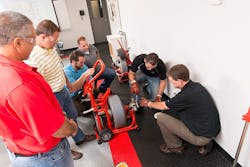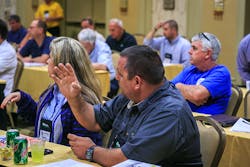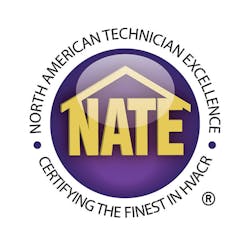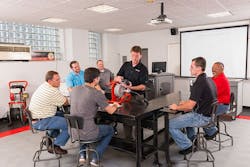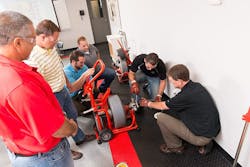Outreach & inroads: benefits of a career in the trades
According to the Plumbing-Heating-Cooling Contractors — National Association, by 2022 the industry will face a shortage of more than 138,000 employees. In April, speaking before the Workforce Development Roundtable on Capitol Hill, Tom Applegate, a member of the PHCC’s Educational Foundation Board of Directors called it a, “Workforce time bomb.”
That dwindling number of plumbers is going to have their work cut out for them. Strict water efficiency standards in new construction will create demand for plumbers who are experts at low-flow systems and fixtures. Construction of power plants and factories will require more pipefitters and steamfitters. States that adopt the International Residential Code will need more plumbers familiar with fire sprinkler systems.
Lack of skilled workers really hurts a contractor’s ability to grow their business, and oftentimes they have to turn away new business—Cindy Sheridan
“We hear from our members that it is a crisis,” Cindy Sheridan, Chief Operating Officer for the PHCC Educational Foundation said. “Lack of skilled workers really hurts a contractor’s ability to grow their business, and oftentimes they have to turn away new business.” That has knock-on effects for the wider economy.
Why are so many well-paying jobs (the 2015 National Occupational Employment and Wage Estimates lists the mean annual wage for a Plumbers, Pipefitters and Steamfitters at $55,100) that offer multiple tracks for advancement going begging?
Crisis of perception
According to Sam Dowdy, owner of S&D Plumbing, Tyler, Texas, and a founder of the Plumbing Pipeline Program, the biggest obstacle to overcome is the poor perception of the trades. The work is often considered “dirty” and “menial.”
The trades are also in competition with other forms of continuing education. The goal of many parents — not to mention high school educators and guidance counselors — is to get their kids into a traditional four-year college. For decades, the four-year degree has been seen as the gateway to middle- and upper-class prosperity.
The real value of a life in the trades is better reflected in the many, many multi-generational plumbing and heating shops across the country. Time and again, sons and daughters have followed their parents into the trades because they’ve seen the prosperity and quality of life the trades can deliver.
Yes, there are sweltering attics in the summertime; of course there are freezing basements in the winter. There are plenty of very early mornings and very late evenings, but there is also pride in one’s knowledge and ability, the pleasure in a job well done, and an independence most other forms of work cannot match.
Apprenticeship is changing
The usual entrance to a plumbing career has been the apprenticeship, and there are certainly more money and resources being diverted into apprenticeship programs.
“The Foundation has a four-year plumbing and HVAC curriculum that’s Department of Labor-approved,” Sheridan said. “Many of our chapters offer apprenticeship programs using that curriculum. The foundation also has an e-learning program on both the plumbing and HVAC side,” for those students who might need supplemental help, or have trouble getting into a physical classroom. At the same time, there are more federal dollars going towards apprenticeship grants.
But most apprenticeship programs require the entrant to be at least 18 years old. By that age most young people have made up their minds either for or against a plumbing career. In response, the PHCC has developed a pre-apprentice program.
“It’s an online program that has six modules,” Sheridan explained. “We hope it can help contractors who have a helper or employees who aren’t sure they want to go through apprenticeship… It gives them a better understanding of the industry and what kind of opportunities there are.”
Sheridan hopes to get the program into schools and also in underserved communities through places like Job Corps (the DOL’s education and training program for young people) and Good Will Industries International.A good idea currently being used in the HVAC industry is the Ready to Work Certificate Exam developed by North American Technician Excellence (NATE). The point of the exam is not to begin training, but to see if the candidates are trainable.
“It’s meant to be a way to further screen candidates to see if they can be trained in the HVAC space moving forward,” Valerie Briggs, director of Marketing and Business Development for NATE, said.
Briggs touts the value of certification as a training and development tool. “We are strengthening our partnership with the PHCC, because a lot of times plumbing companies work in that HVAC space,” she said. (NATE will be attending Comfortech 2016 and the PHCC’s next National Conference.)
While the ASSE is working on a plumbing certification program, and while the industry trend has been towards accreditation, certification and so-called “stackable skills,” Cindy Sheridan believes the real challenge is in finding well-rounded individuals who will make good employees. “They have to be able to identify problems, and problem solve,” Sheridan said.
Get ‘em while they’re young
The search for those individuals has some contractors going well beyond traditional outreach to community colleges or vocational schools. Sam Dowdy, for example, speaks out about the merits of the plumbing trade in career days at local high schools and even at elementary schools.
Gordy Noe, president of Pioneer Heating and Air, Knoxville, Tennessee, has pioneered what he calls the Ride and Decide Program: high school juniors and seniors get to ride along with service technicians and get a better feeling for the work and what it entails. They even get paid!
Steve Coscia, the owner of Coscia Communications (and a Comfortech 2016 session presenter) said, “Many contractors have become more aggressive at working with the local high schools to approach students who are maybe only 12, 13, 14 years old.”
Recruiting that next generation into the trades often means tailoring programs to fit them, often with online offerings. NATE now sells an app in its online store. The PHCC is now using simulation software based on gaming technology to increase user interest.
Some young people who have the desire to enter the trades have been ill-prepared by their education. Among the PHCC’s educational offering is a new one on interactive construction math. “One of the biggest challenges we hear that students have is often the math component,” Cindy Sheridan said. “As products become more technologically advanced they need to have those math skills, those science skills.”
Another difficulty for many young people entering the trades are the so-called “soft skills.” These are things often taken for granted, such as: How to be a responsible employee, how to talk to a customer, and how to act like a brand representative. A technician can have a great deal of know-how, but if, for example, they never show up to work on time, then they aren’t an employee you want on your team.
Coscia Communications publishes a soft skills curriculum that is now in use in about 160 community colleges, trade schools and other facilities. More and more contractors who do in-house training are incorporating soft skills into their own programs. “One of the colleges that uses my curriculum had a student that won the state championship for SkillsUSA in the topic of customer service,” Coscia said. “Now he’s got a good job with a contractor in Tulsa, Oklahoma.”
Manufacturers — the missing piece?
One of the PHCC’s corporate partners in attendance at their Capitol Hill roundtable in April was Bradford White’s director of marketing Carl Pinto. “The workforce challenge extends well beyond p-h-c contractors,” Pinto said. “There is a ripple effect on the industry, including manufacturers and wholesalers… Bradford White needs professionals to install our products.”
Manufacturers have recognized the business sense in developing their own training programs and making them more accessible. Examples include Weil-McLain’s School of Better Heating, Xylem’s Little Red Schoolhouse, InSinkErator’s eLearning Center and A.O. Smith University, just to name a few.
“We have been committed to training our customers and distributors for a very long time,” Christopher Burton, global director of Brand Management for Ridgid, said.
Around the world Ridgid has 14 training centers, with their flagship being the Schoolhouse located on the company campus in Elyria, Ohio. The 15,000-sq.ft. facility boasts two full-time instructors (one of which is bi-lingual in Spanish and English) who provide more than 1,700 hours of instruction every single year.
The three floors of classrooms have separate labs dedicated to pipe fabrication, drain cleaning, diagnostics and locating, hand tools and more. They have a series of renovations under way to improve the look and feel of the Schoolhouse.
Chiefly, Ridgid sees the value for its distributors, its customers and its employees (particularly its sales and support staff). But the company is also serious about the role they play in their community. “Whether it be a local vocational school or a local high school engineering department,” Burton said, “we love to see these folks come out to our campus. And of course we take them over to the Schoolhouse, so they can get a better understanding of the full length of our product catalog.”
The OEMs will definitely have a role to play in the future of training and workforce development. The Plumbing Pipeline Program, which seems like a model for how to address the “workforce time bomb,” was created in a partnership between a plumbing contractor — S&D Plumbing — the Texas PHCC, the Texas State Technical College and a manufacturer, Milwaukee Tool. Food for thought.
About the Author
Steve Spaulding
Editor-in-Chief - CONTRACTOR
Steve Spaulding is Editor-in-Chief for CONTRACTOR Magazine. He has been with the magazine since 1996, and has contributed to Radiant Living, NATE Magazine, and other Endeavor Media properties.
